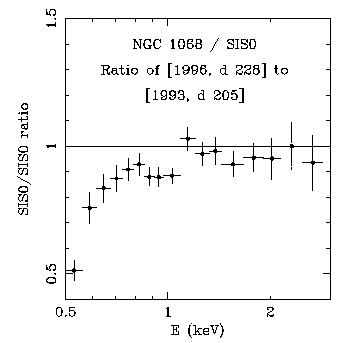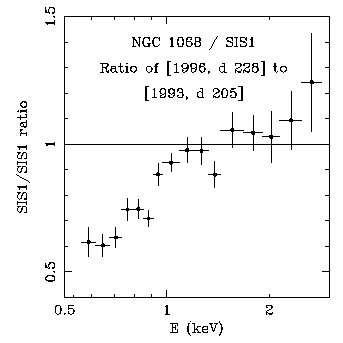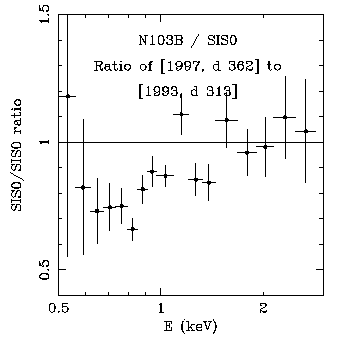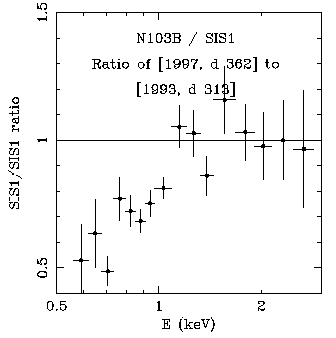Absolute Model-Independent Calibration Points
As mentioned above we found only THREE sources suitable for obtaining the absolute SIS degradation in the entire ASCA public database (NGC 4636, NGC 1068 and N103B). These are the only sources that satisfy the stringent but necessary requirements described above. (If the reader knows of a suitable source that we missed, please let us know). All three sources were of course observed in the PV phase (one of the necessary requirements) and all three have the added bonus that the second observation in each case had a relatively high exposure time. NGC 4636 is an elliptical galaxy so the soft spectrum, at least, is constant in time, as it should be for NGC 1068 which is a Seyfert 2 galaxy in which the soft X-ray emission is extended. N103B is a supernova remnant so the entire spectrum should be constant.
For NGC 1068 and N103B, Figures 4a to 4d below show two spectral ratios between the AO and PV observations (for SIS-0 and SIS-1). It can be seen that the ratios can be crudely modeled with an excess absorbing column. We do not show the corresponding ratios for NGC 4636 because they are not simple to interpret. This is because the source is extended and the PV observation was made in 4-CCD mode, with significant flux falling off the nominal chips. The effective excess NH values derived from spectral fitting the PV and AO spectra are fine, however. The six values of the effective NH derived from these data are plotted in Figure 5.
 |
 |
 |
 |
Absolute Multi-Mission Calibration Points
ASCA/RXTE and BeppoSAX observed 3C 273 simultaneously on three occassions. We can use the LECS on BeppoSAX to compare with the ASCA SIS. Of course, this does not necessarily mean that the absolute calibration of the LECS is perfect but such an excercise will add more data points to the investigation. We spectral fit the LECS, SIS-0 and SIS-1 data simultaneously with a power-law plus Galactic absorption, allowing independent, extra column densities for each SIS. The results are plotted in Figure 5. Currently we only have measurements for the June 1998 observation; work is in progress for the other two.
Absolute SIS/GIS Calibration Points
Finally, we can compare the SIS data with the GIS data. This method suffers the most from systematic effects. The GIS response diminishes below 0.7 keV and the accuracy of the low-energy calibration is limiting. Also, if the source spectrum is already (intrinsically) absorbed then we cannot get a handle on the "excess NH" from spectral fitting data from the detectors simultaneously. The method works best for sources which are bright and which do not appear to be intrinsically absorbed. The latter condition effectively means that it only works well when the CCD degradation is small, because otherwise we cannot tell whether there is significant intrinsic absorption, unless there is an independent way of knowing (e.g. ROSAT data). Since methods 1-3 above leave a gap during the period between 1994 and 1996 when the degradation was small, we searched for suitable ASCA observations from this period and found three. Values of the excess NH derived are plotted in Figure 5.
Previous: Degradation of SIS-1 relative to SIS-0
Next: Relation Betweein the Low-Energy SIS Degradation and Time
Back: "SIS Low-Energy Degradation" Main Page
This file was last modified on Monday, 30-Jul-2001 18:17:25 EDT
Curator:
HEASARC Guest Observer Facility
If you have any questions concerning ASCA, visit our Feedback form.

